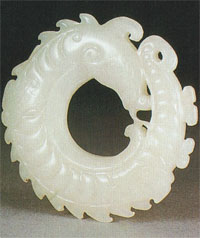Chinese Jade Culture
Jade (Yu in Chinese pinyin) was defined as beautiful stones by Xu Zhen (about 58-147) in Shuo Wen Jie Zi, the first Chinese dictionary. Jade is generally classified into soft jade (nephrite) and hard jade (jadeite). Since China only had the soft jade until jadeite was imported from Burma during the Qing dynasty (1271-1368), jade traditionally refers to the soft jade so it is also called traditional jade. Jadeite is called Feicui in Chinese, which is now more popular and valuable than the soft jade in China.
 The history of jade is as long as the Chinese civilization. Archaeologists have found jade objects from the early Neolithic period (about 5000 BC), represented by the Hemudu culture in Zhejian Province, and from the middle and late Neolithic period, represented by the Hongshan culture along the Lao River, the Longshan culture along the Yellow River, and the Liangzhu culture in the Tai Lake region. Jade has been ever more popular till today.
The history of jade is as long as the Chinese civilization. Archaeologists have found jade objects from the early Neolithic period (about 5000 BC), represented by the Hemudu culture in Zhejian Province, and from the middle and late Neolithic period, represented by the Hongshan culture along the Lao River, the Longshan culture along the Yellow River, and the Liangzhu culture in the Tai Lake region. Jade has been ever more popular till today.
The Chinese love jade because of not only its beauty, but also more importantly its culture, meaning and humanity, as Confucius (551 BC - 479 BC) said there are 11 De (virtue) in jade. The following is the translation (don't know the translator):
'The wise have likened jade to virtue. For them, its polish and brilliancy represent the whole of purity; its perfect compactness and extreme hardness represent the sureness of intelligence; its angles, which do not cut, although they seem sharp, represent justice; the pure and prolonged sound, which it gives forth when one strikes it, represents music. Its color represents loyalty; its interior flaws, always showing themselves through the transparency, call to mind sincerity; its iridescent brightness represents heaven; its admirable substance, born of mountain and of water, represents the earth. Used alone without ornamentation it represents chastity. The price that the entire world attaches to it represents the truth. To support these comparisons, the Book of Verse says: "When I think of a wise man, his merits appear to be like jade."'
Thus jade is really special in Chinese culture, also as the Chinese saying goes "Gold has a value; jade is invaluable."
Because jade stands for beauty, grace and purity, it has been used in many Chinese idioms or phrases to denote beautiful things or people, such as Yu Jie Bing Qing (pure and noble), Ting Ting Yu Li (fair, slim and graceful) and Yu Nv (beautiful girl). The Chinese character Yu is often used in Chinese names.
The jade dragon picture adopted from "Chinese Ancient Jade Catalog".
Related:
Colorful Rice Cooked in Bamboo Tubes

